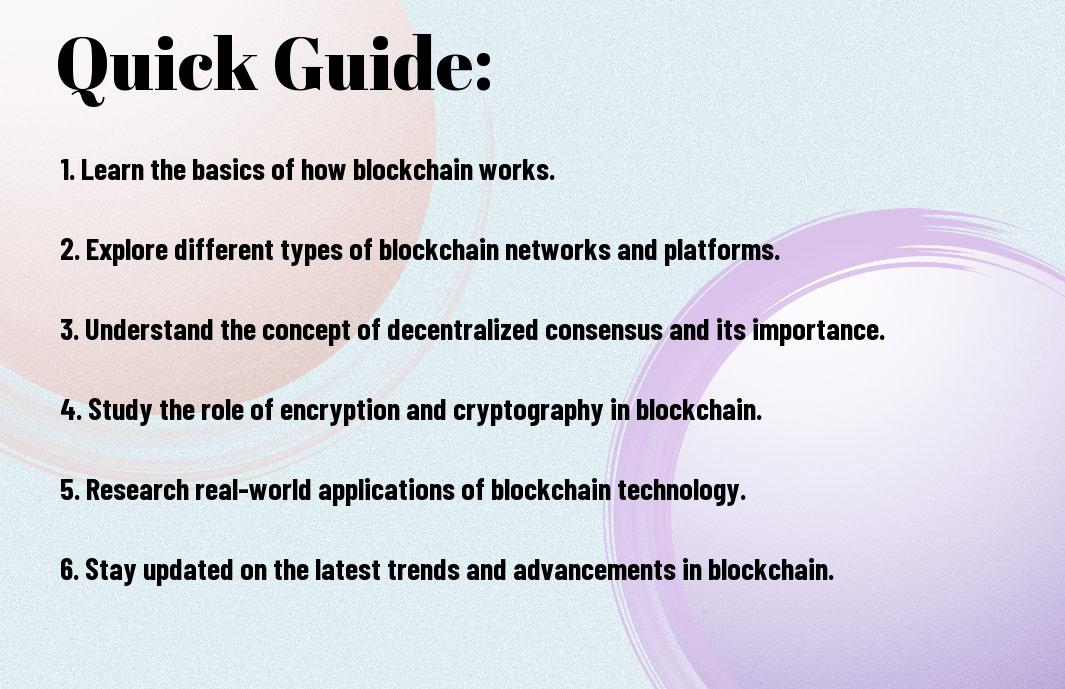You’ve probably heard about Blockchain technology and its potential to revolutionize industries, but do you really understand how it works? Don’t worry, we’ve got you covered! In this guide, we’ll break down the foundational concepts and key components of Blockchain in a way that’s easy to understand. From its secure and transparent nature to its decentralized network, we’ll explore the positive aspects of Blockchain technology. We’ll also touch on the potential risks and challenges associated with this innovative technology. By the end of this guide, you’ll have a solid grasp of Blockchain technology and its limitless possibilities.

Understanding the Basics
What is Blockchain Technology?
Now, let’s investigate into the basics of blockchain technology. Blockchain technology is a decentralized, distributed ledger technology that securely records transactions across a network of computers. Each block contains a number of transactions, and every time a new transaction occurs on the blockchain, a record of that transaction is added to every participant’s ledger.
Key Principles Simplified
Basics: A fundamental concept of blockchain technology is its immutability, meaning once data is recorded on the blockchain, it cannot be altered or tampered with. Additionally, transparency is a key principle, as all participants in the network can view the transactions. Consensus mechanism ensures that all parties agree on the validity of the transactions, adding another layer of security.
Blockchain technology’s key principles of immutability, transparency, and consensus create a secure and trustless environment for transactions to take place, eliminating the need for intermediaries and reducing the risk of fraud or manipulation.
Discovering Types of Blockchains
Clearly, there are several types of blockchains that exist, each with its unique characteristics and purposes. Understanding the differences between these types can help you grasp the full potential of blockchain technology.
| Public Blockchains | Private Blockchains |
| Consortium Blockchains | Permissioned Blockchains |
| Hybrid Blockchains | Federated Blockchains |
| Proof of Work (PoW) Blockchains | Proof of Stake (PoS) Blockchains |
| Smart Contract Blockchains | Non-Blockchain DLTs |
Public vs. Private Blockchains
Little is known about the difference between public and private blockchains. Public blockchains allow anyone to participate and maintain the network, while private blockchains are restricted to specific users or organizations. Knowing when to use each type is crucial for any blockchain project.
Other Blockchain Variants to Know
An understanding of other blockchain variants is important for those exploring the technology. Private blockchains, consortium blockchains, and hybrid blockchains offer different levels of control and security based on the requirements of the users. Knowing these variants can help in making informed decisions.
Step-by-Step Guide to How Blockchains Work
| A Peek Under the Hood: Block Creation | Linking the Chain: Ensuring Security and Trust |
A Peek Under the Hood: Block Creation
For a blockchain to function, transactions are bundled into blocks, and each block contains a unique identifier, a reference to the previous block, and a set of transactions. Miners work to solve complex mathematical puzzles to validate the transactions, and once solved, the new block is added to the chain.
Linking the Chain: Ensuring Security and Trust
You might wonder how blockchains ensure security and trust. Well, each block includes a cryptographic hash of the previous block, creating a chain that makes altering any block almost impossible. Additionally, consensus mechanisms such as Proof of Work or Proof of Stake help validate transactions and maintain the integrity of the network.
Peek: Understanding the security features of a blockchain is crucial. The cryptographic hash linking each block together ensures tamper resistance, making it highly secure. Consensus mechanisms play a vital role in validating transactions and preventing fraudulent activities, ensuring trust within the network.
Factors Influencing Blockchain Adoption
Keep up with the growing interest in blockchain technology by understanding the key factors that influence its adoption. Factors such as regulatory guidelines, industry use cases, technological advancements, and public perception play a crucial role in the widespread adoption of blockchain technology. Companies and organizations must consider these factors when implementing blockchain solutions to ensure successful integration and adoption.
Industry Use Cases
On the forefront of blockchain adoption are various industries utilizing the technology to streamline operations, enhance transparency, and improve security. Industries such as finance, healthcare, supply chain, and real estate are leveraging blockchain to create innovative solutions that address specific challenges within their sectors. These industry use cases demonstrate the versatility and potential impact of blockchain technology across various fields.
Regulatory and Technical Challenges
Technical challenges and regulatory frameworks pose significant obstacles to the widespread adoption of blockchain technology. Issues such as scalability, interoperability, data privacy, and compliance with existing regulations must be addressed to ensure the successful implementation of blockchain solutions. For instance, navigating the complex regulatory landscape and overcoming technical barriers requires collaboration between industry stakeholders and regulatory bodies.
This emphasizes the need for ongoing dialogue and collaboration to address these challenges and foster a supportive environment for blockchain adoption.
Tips for Navigating Blockchain Complexity
All beginners entering the world of blockchain technology may feel overwhelmed by its complexity. Here are some tips:
- Start with the basics: Understanding the foundational concepts of blockchain is vital before delving into more complex topics.
- Stay updated: The technology is constantly evolving, so it’s crucial to keep up with the latest trends and developments.
- Join communities: Engaging with fellow enthusiasts and experts can provide valuable insights and support.
- Experiment: Practical experience through building projects or participating in test networks can enhance your understanding.
Perceiving the intricacies of blockchain technology requires patience, dedication, and continuous learning. Embrace the challenges as opportunities for growth.
Developing a Blockchain Mindset
Blockchain technology revolutionizes data security and transparency through decentralized networks and immutable ledgers. Embracing a blockchain mindset involves thinking in terms of trustless systems, smart contracts, and distributed consensus mechanisms. By cultivating a mindset focused on innovation and collaboration, individuals can harness the full potential of blockchain technology for various industries.
Resources and Communities to Follow
While there are numerous resources and communities dedicated to blockchain technology, it’s vital to choose wisely. Opt for reputable sources such as industry blogs, official whitepapers, and established online communities like Reddit’s r/cryptocurrency or Stack Exchange’s Blockchain forum. These platforms provide valuable insights, discussions, and updates on the latest blockchain trends and projects.
Tips shared by experienced blockchain enthusiasts in these communities can help newcomers navigate the complexities of the technology more effectively.
Weighing Blockchain: The Pros and Cons
| Pros | Cons |
|---|---|
| Decentralization | Energy Consumption |
| Transparency | Scalability Issues |
| Security | Regulatory Challenges |
| Immutability | Cost |
The Revolutionary Potential of Blockchain
Some see blockchain technology as a revolutionary force that can transform industries by providing unmatched security, transparency, and efficiency. Its potential to streamline processes, reduce fraud, and empower individuals by granting them more control over their data is truly groundbreaking.
Considerations and Cautions
Now, as with any emerging technology, there are considerations and cautions to bear in mind when exploring blockchain. It’s important to acknowledge the energy-intensive nature of blockchain processes and the potential scalability issues that could arise as the technology continues to expand.
The regulatory challenges surrounding blockchain must also be carefully navigated to ensure compliance and widespread adoption. Additionally, the cost implications of implementing blockchain solutions should be evaluated to determine the feasibility of integration within existing systems.

Summing up
With this in mind, understanding blockchain technology is key to grasping its potential in revolutionizing various industries and processes. By recognizing its decentralized and secure nature, as well as its ability to streamline transactions and data sharing, individuals and businesses can leverage this technology to enhance efficiency and transparency. Embracing blockchain can lead to innovative solutions and opportunities that shape the future of finance, logistics, healthcare, and beyond.
FAQ
Q: What is blockchain technology?
A: Blockchain technology is a decentralized, distributed ledger system that records transactions across multiple computers in a way that is secure, transparent, and resistant to tampering.
Q: How does blockchain technology work?
A: Blockchain technology works by creating blocks of data that are linked together in a chain. Each block contains a list of transactions, a timestamp, and a unique cryptographic hash. These blocks are stored on a network of computers, making it extremely difficult for any single entity to control the data.
Q: What are the benefits of blockchain technology?
A: Some of the key benefits of blockchain technology include enhanced security, transparency, efficiency, and reduced costs. It also allows for peer-to-peer transactions without the need for a trusted intermediary, revolutionizing industries like finance, supply chain, healthcare, and more.
